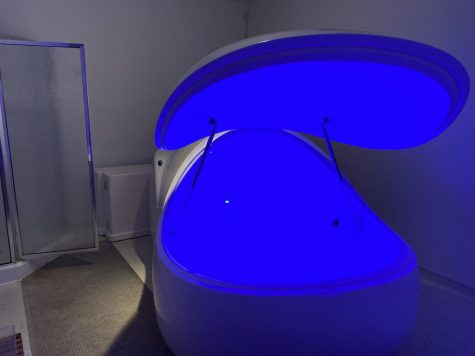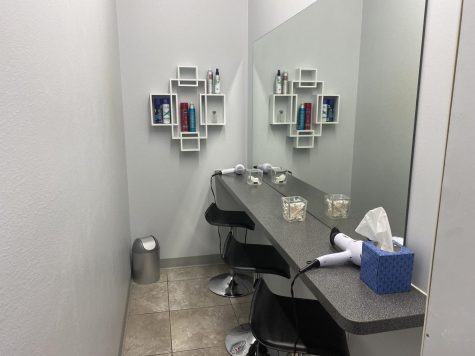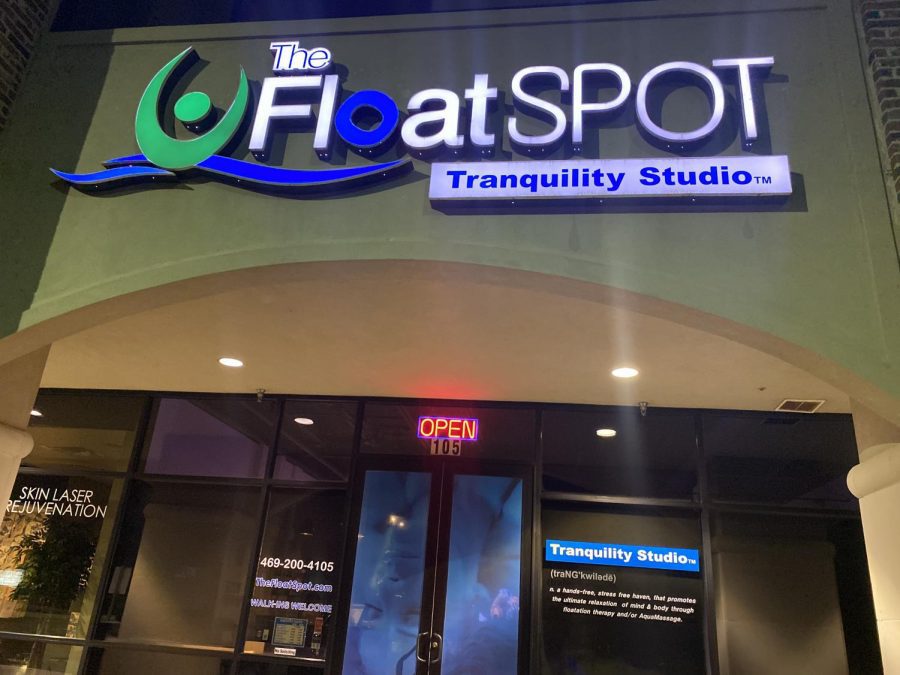Review: Are sensory deprivation tanks worth it?
The Float Spot, located in Frisco on Legacy Drive, offers sensory deprivation tank sessions and aqua-massages. More information about the services and booking can be found on their website www.thefloatspot.com. “I had a fantastic experience, and I don’t regret trying it out,” reviewer Maddie Moats said. “It helped me unwind and was just an overall cool thing to experience at least once.”
About The Float Spot
Located off Legacy Drive in Frisco, and owned by Ray Thoma, The Float Spot offers sensory deprivation tank sessions and aqua-massages. The sensory deprivation tanks, which is what I tried, are pods filled with warm water super-saturated with Epsom salt that causes your body to float and relax. Their website claims that floating helps with stress, depression, recovery from exercise, chronic pain, relaxation during pregnancy, jet lag, meditation, better sleep or just to clear one’s mind.
When I spoke with employee Jackie Krenowicz, she said that the most important benefit to sensory deprivation tanks is the magnesium in the salt, which helps with muscle relaxation and flexibility, as well as mental relaxation.
“We are all lacking magnesium,” Krenowicz said. “But in the tank there is 1,100 pounds of magnesium, so while you are laying there your body absorbs it really well, and that’s why you feel so refreshed.”
People that float preach the benefits, but The Float Spot wants its customers to go into it without any expectations or preconceptions to ensure that they have an authentic experience.
This experience comes in different packages at different prices. A 30-minute float costs $49, an hour costs $65, and two hours costs $110. They also have a “Happy 1/2 Hour Float,” which is 30 minutes for $30 if you go Tuesday – Thursday between 12 p.m. and 5 p.m. Other pricing packages can be found on their website.
My experience
I booked my appointment online and the process was simple. I entered my card information when I booked to hold my appointment, but I wasn’t charged until after my float. The website was easy to navigate, however, I did notice what I think were intended to be subliminal messages on one page. In the water of a tranquil picture on a page of their website, hidden messages read “You need to float” and “Time to float.” This freaked me out slightly, but I still wanted to try it.

A screenshot of possible subliminal messaging is found on The Float Spot’s website. In small, faint lettering hidden in the water below the tree, messages read, “You need to float,” and “Time to float.” The Float Spot’s website can be found at www.thefloatspot.com.
Before
When I arrived at the studio, an employee greeted me and asked that I fill out a waiver that addressed different safety concerns. Then, I was showed around and brought to the room where I would float. Instructions came before, during and after the float. The employee also asked about what music and for how long I wanted it to play. I chose the recommended 10 minutes in the beginning and a five-minute “wake up call” at the end. The room had a shower, a bench and a hanger for your belongings. The float pod in the center of the room was clean, spacious and private, and the door was lockable.

The room displays the float pod. A shower is located in the corner for before and after the float, and shampoo, conditioner and body wash is provided. An area to put all items is also provided.
First, I hopped in the shower to rinse off before entering the pod, and this is just to ensure that they stay clean from cosmetic products or oils. I recommend that anyone floating arrive without any makeup on, so they don’t have to use the baby wipes provided to remove it.
Next, I got into the sensory deprivation tank and pressed the call button on the side to signal to the employee in the other room that I was ready to begin. Through the speakers in the pod, she started playing the relaxing music. I then pressed the other button in the tank that turned off the lights. I opted to leave the tank open, as pictured in the image above because I didn’t want to feel trapped or nervous.
During
When I was in the water, which was a comfortable and warm temperature, my body felt supported and suspended in the super-saturated Epsom-salt water. It took me a while to get situated, and in the process, I did manage to splash salt water in my eye. It stung. I stupidly fumbled around through the tank in the darkness for a minute trying to find the spray bottle of water provided to flush my eyes in case this happened, and I just ended up getting more saltwater in the same eye. I finally turned the lights in the pod back on to grab the bottle hanging off the pod and sorted it out, but my eye still stung for about five minutes. The only other pains I experienced from the salt in the tank was a pretty slight sting on my back where I guess a pimple was located.
Once my eye stopped stinging, I relaxed to the tranquil music. When the music turned off, the complete silence initially freaked me out, but then I focused on breathing deeply and relaxing my entire body. For the last half of my float, I lost feeling in my limbs, but in a good way. I was so relaxed, letting the water and its buoyancy completely support me. It was incredible. In the end, I couldn’t even distinguish my body from the water. It was the most tranquil I have ever felt.
When the wake-up call music played, I knew my float was coming to an end, and when the music finally turned off, signaling my 30 minutes was up, I did not want to move.
After
I got out of the sensory deprivation tank and washed off in the shower with the provided shampoo, conditioner, and body wash — which smelled amazing. I then got all my stuff together and walked out into the “beauty bar.” They have hairdryers, hair products, spray deodorants, cotton pads, and Q-tips. I didn’t use anything except the Q-tips, but I thought it was nice to have the option.

The beauty bar is located right outside the sensory deprivation tanks. It has hairdryers and hair products, cotton pads and spray deodorant. Customers can use this after they float.
And with that, my sensory deprivation tank experience ended. For the rest of that night, I felt rejuvenated, like a weight was lifted off of me. I was really happy and optimistic. These benefits of the float are supposed to last up to five days, but toward the end of the next day, I lost most of my post-float feeling because of my seasonal allergies.
Other Reviews
Before scheduling my appointment, I looked at reviews on Yelp and Google to check the legitimacy of the place. I was surprised at the number of positive reviews, and it was quite difficult to find any negative reviews. Some of the complaints noted that the location didn’t respond to phone calls, and a few addressed disappointment with the water-massage treatment not being what they expected.
In the studio, a hallway stands lined with reviews from customers after their float. Before I floated, I thought some of the messages sounded slightly insane and even a little drug-induced. But after, I understood why they were so enthusiastic. Most of the notes thank The Float Spa for an incredibly relaxing experience, but some of them are more colorful.

“I felt like I was in heaven, away from the world. Just me and myself and my dreams,” one said.
“What an out of body experience! This was honestly incredible. M-I-N-D B-L-O-W-N,” another said.
“I felt like I was in the womb!”
“What just happened? I liked it.”
So, is it worth it?
I had a fantastic experience, and I don’t regret trying it out. It helped me unwind and was just an overall cool thing to experience at least once. The only drawback to going regularly is the expense. I can’t justify budgeting regular appointments for myself, but I think it’s a great splurge for anyone that is notably stressed or looking for a way to recover from intensive exercise. Or, like me, if they were just curious and wanted to try it out. With that said, I would encourage everyone to try the unique and relaxing experience that is the sensory deprivation tank at least once.
Editor’s note: updated for clarity and style Feb. 6.
Your donation will support the student journalists of Prosper High School. Your contribution will allow us to purchase equipment and cover our annual website hosting costs.













